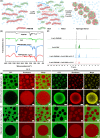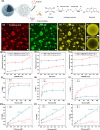Thermo-responsive aqueous two-phase system for two-level compartmentalization
- PMID: 39117632
- PMCID: PMC11310206
- DOI: 10.1038/s41467-024-51043-z
Thermo-responsive aqueous two-phase system for two-level compartmentalization
Abstract
Hierarchical compartmentalization responding to changes in intracellular and extracellular environments is ubiquitous in living eukaryotic cells but remains a formidable task in synthetic systems. Here we report a two-level compartmentalization approach based on a thermo-responsive aqueous two-phase system (TR-ATPS) comprising poly(N-isopropylacrylamide) (PNIPAM) and dextran (DEX). Liquid membraneless compartments enriched in PNIPAM are phase-separated from the continuous DEX solution via liquid-liquid phase separation at 25 °C and shrink dramatically with small second-level compartments generated at the interface, resembling the structure of colloidosome, by increasing the temperature to 35 °C. The TR-ATPS can store biomolecules, program the spatial distribution of enzymes, and accelerate the overall biochemical reaction efficiency by nearly 7-fold. The TR-ATPS inspires on-demand, stimulus-triggered spatiotemporal enrichment of biomolecules via two-level compartmentalization, creating opportunities in synthetic biology and biochemical engineering.
© 2024. The Author(s).
Conflict of interest statement
H.C.S. is a scientific advisor of EN Technology Limited, MicroDiagnostics Limited and Upgrade Biopolymers Limited in which he owns some equity, and also a managing director of the research center, namely Advanced Biomedical Instrumentation Center Limited. The works in the paper are however not directly related to the works of these entities. The remaining authors declare no competing interests.
Figures






Similar articles
-
Facile design and development of photoluminescent graphene quantum dots grafted dextran/glycol-polymeric hydrogel for thermoresponsive triggered delivery of buprenorphine on pain management in tissue implantation.J Photochem Photobiol B. 2019 Aug;197:111530. doi: 10.1016/j.jphotobiol.2019.111530. Epub 2019 Jun 6. J Photochem Photobiol B. 2019. PMID: 31279287
-
Aqueous Two-Phase System (ATPS)-Based Polymersomes for Particle Isolation and Separation.ACS Appl Mater Interfaces. 2020 Dec 9;12(49):55467-55475. doi: 10.1021/acsami.0c16968. Epub 2020 Nov 25. ACS Appl Mater Interfaces. 2020. PMID: 33237722
-
Membraneless Compartmentalization Facilitates Enzymatic Cascade Reactions and Reduces Substrate Inhibition.ACS Appl Mater Interfaces. 2018 Sep 26;10(38):32782-32791. doi: 10.1021/acsami.8b07573. Epub 2018 Sep 14. ACS Appl Mater Interfaces. 2018. PMID: 30179001 Free PMC article.
-
Temperature-responsive smart packing materials utilizing multi-functional polymers.Anal Sci. 2014;30(1):167-73. doi: 10.2116/analsci.30.167. Anal Sci. 2014. PMID: 24420259 Review.
-
Current experimental, statistical, and mechanistic approaches to optimizing biomolecule separations in aqueous two-phase systems.J Chromatogr A. 2025 May 24;1749:465881. doi: 10.1016/j.chroma.2025.465881. Epub 2025 Mar 17. J Chromatogr A. 2025. PMID: 40127604 Review.
References
MeSH terms
Substances
Grants and funding
- No. N_HKU718/19/National Natural Science Foundation of China (National Science Foundation of China)
- 52003287/National Natural Science Foundation of China (National Science Foundation of China)
- 22302128/National Natural Science Foundation of China (National Science Foundation of China)
- Nos. 17317322, 17306221, 17306820, C7165-20GF/Research Grants Council, University Grants Committee (RGC, UGC)
LinkOut - more resources
Full Text Sources

